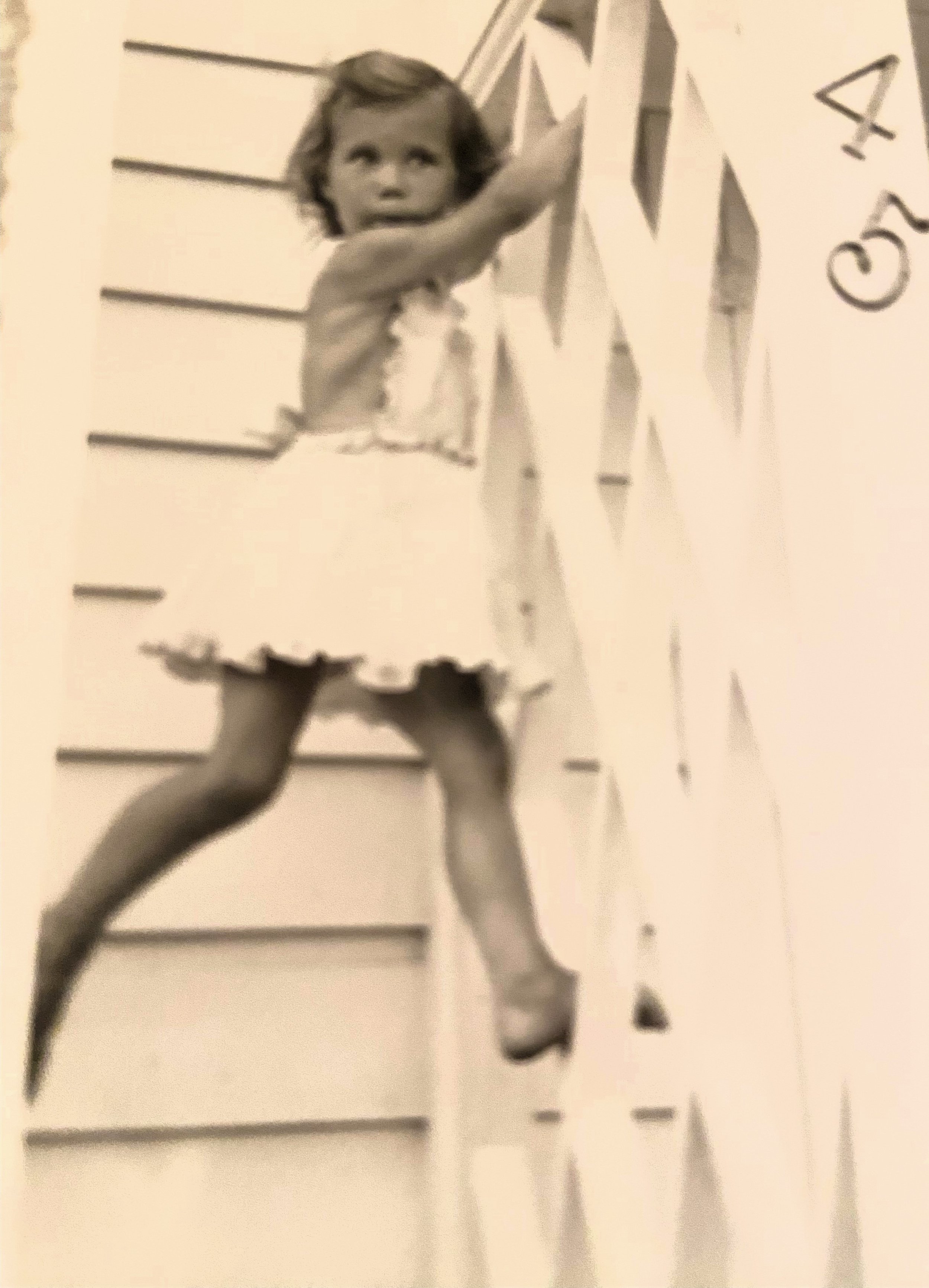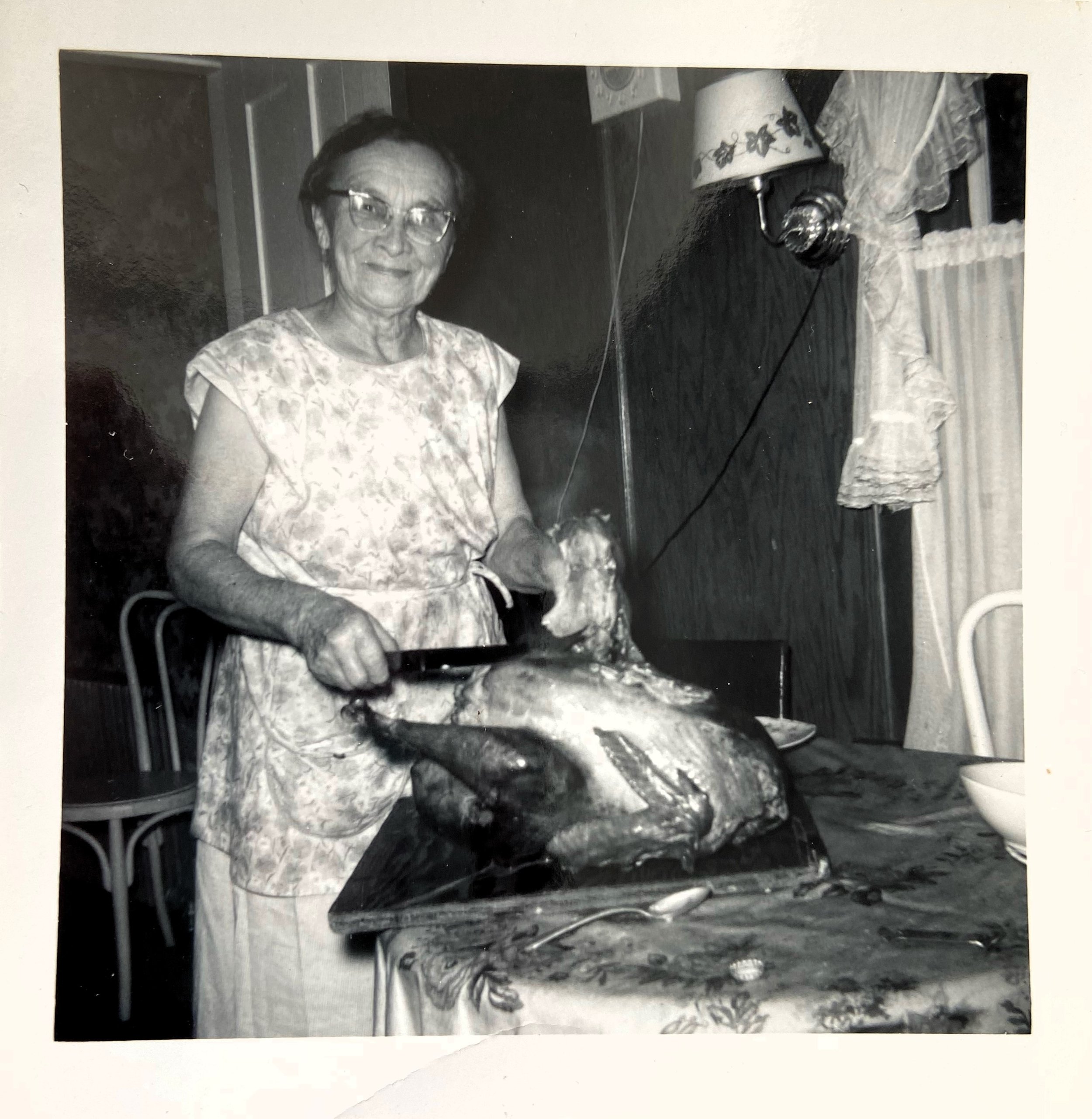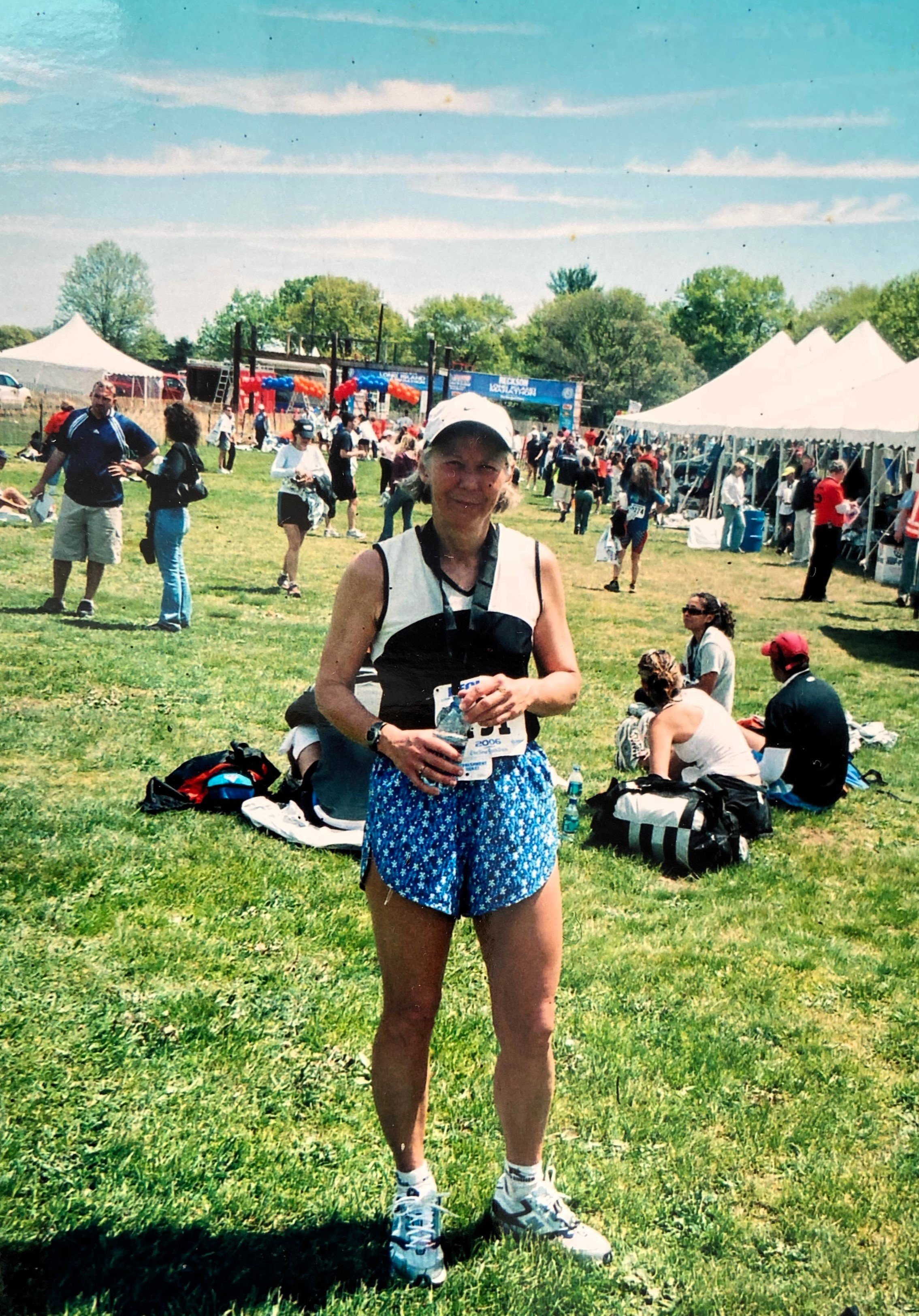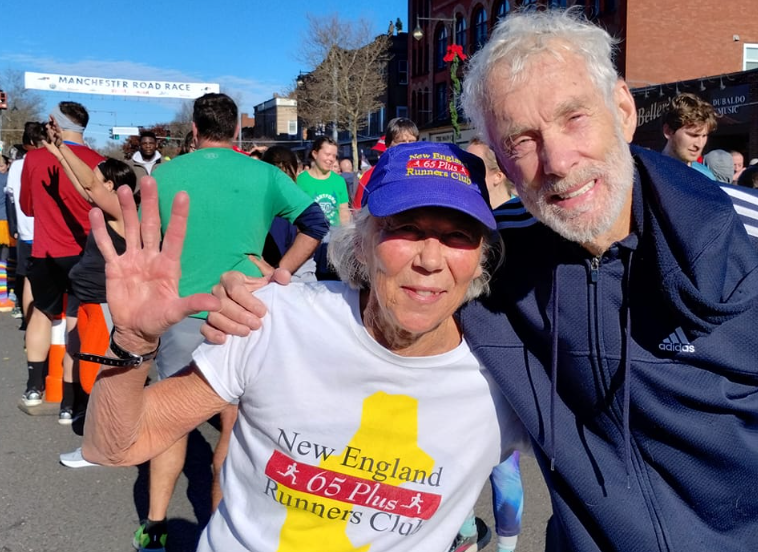Janet Romayko
Finish line of the East Lyme marathon 1982 with her husband
Janet Romayko is a veteran of 49 marathons and countless triathlons including the half-Ironman distance. But what she is most thrilled with is her 50 consecutive finishes at the Manchester Road Race in Manchester CT, a 4.748-mile race held on Thanksgiving Day and started in 1927. The race is very special to Janet as she grew up literally on the course. Her grandmother took her to watch the runners pass by their street when she was four years old, a tradition they kept until she went to college in 1963. When her aunt was 93, she walked the course. You could say that the Manchester Road Race is in her DNA.
Romayko was born in 1945 in Manchester Memorial Hospital. Her father was still in the Pacific where he was stationed during WWll as a US Navy Seabee. It took him some time to return home after the war, so Romayko and her mother and aunt lived with her grandmother in Manchester, whose address just happened to coincide with Mile One of the Manchester course.
Showing off her athleticism at age 3.
When her father returned home he started a construction business and her mother managed the company. Post WWll neighborhoods were teeming with kids and Janet’s was no exception. “We had six kids next door so we had ready-made baseball, football, bike rodeo teams, and ice skating in the winter,” recalls Romayko. “We were always on the go, always moving. Our neighbor had a fresh milk delivery business so we ate very healthy from the farms and gardens and we played with the cows. We learned how to referee, negotiate our differences, and fix our own fights.”
They were a family constantly in motion. Her mother golfed and was a competitive swimmer, achieving All-American status at age 85 and her aunt, also a competitive swimmer, at age 90. Her father was a talented baseball player drafted by the Chicago White Sox, but the war interrupted his professional baseball aspirations. Her younger sister was a very competitive golfer.
Sport was a big part of their family fiber but growing up female in the ’50s and ’60s there were no organized school sports for Romayko to participate in. Even with 800 kids in her graduation class, there was nothing for females except cheerleading. Things started to change for her in 1972, after Title IX was passed. Running clubs started to spring up and she joined one. Her first race was in Hartford, CT. Dannon Yogurt was the sponsor and after the race all the participants got an expired Dannon Yogurt cup. Running was going through its first boom. Monday mornings at work everyone stood around the water cooler and talked about their weekend races. She loved being a part of it.
Romayko started to hear the rumblings of the early ’70s women’s movement. She wanted to get involved but wasn’t the mover and shaker type. “I wasn’t the type who was going to go to demonstrations and burn my bra,” she laughs. But she did write numerous letters to congressmen. Women were speaking up and she did her part quietly.
Her grandmother who started Janet’s Manchester Road Race tradition carving a 28 pound turkey after one of Janet’s races.
In 1971 while watching the Manchester race with her grandmother, she suggested that Romayko just jump in. “I thought about it but I was a “good girl” and wouldn’t allow myself to break the rules. But in 1972, she had a different outlook. She jumped into the race at Mile 4 for a bit and felt this is something she could do. “For me, this was a way to test parts of the course, especially the hills, to see if I could complete it,” Romayko explains.
She met her husband, James Hodges, that same year. He had been a collegiate squash player and took up running to stay in shape. He invited her to run with him and on their runs she talked about the Manchester Road Race. After countless runs of hearing about the race, he talked her into jumping on the course and running it in 1973 (the race banned females till 1974). “I knew the course so well that this was easy for me,” explains Romayko. “No one really noticed me. People of both genders always jumped into the race.” Her husband and uncle, another great supporter of hers, scouted different sections of the course to see where she should jump in. She wore men’s clothing to disguise herself and her husband ran with her to the Hungry Tiger location (Mile One) and then her uncle ran with her till Mile 4. After that, she was on her own. As she recalls, “I figured runners would be huffing and puffing up the hill and I was doing the same. Everyone concentrates going up the hill as it is SOOO long and once you are up to Highland Park Market there is yet another 2/10 of a mile to go. Going downhill is easier on the legs or so it was for me.” She completed the course without interference from anyone. “No one seemed to care that a female was on the course,” she recalls. “Besides, with my male disguise I looked like a big paper bag,” she laughs. Her time was not recorded.
She credits her husband and uncle for giving her the conviction that she could run the course and do it in a good time.
Romayko’s streak of 50 consecutive Manchester Road races was almost in jeopardy when she broke her kneecap in 2012. One month before the race she slipped on a marble floor and thought, “Jeepers, this is bad.” For the average 70-year-old, this would have meant the end of her running days. But for someone as fit as she was, who runs and bikes and swims 40 miles a week as part of her routine, there was hope of recovering.
Long Island Marathon 1986 to 2006 age group winner every year
She went to an orthopedic doctor she knew was a runner and told him she needed to keep the streak going and make sure he got her to the start. They decided against surgery. Instead, he put her in a soft cast from her ankle to her hip with the warning not to move. She was the perfect patient. When the cast came off three days before the race she headed to the pool and used a kick board to loosen the muscles in her leg. She gives credit to Joan Benoit Samuelson who used the pool to recover from her knee surgery three weeks before winning the 1984 first Olympic Women’s Marathon. “She definitely is my hero,” states Romayko.
On race day she surrounded herself with friends whose job was to keep her from falling and keep the other runners away from her. She mostly walked but completed the course. “I was really afraid but it was important to me to keep the streak going,” recalls Romayko.
When asked what has changed in running and Manchester, she first points to gear and technology. “I can’t get over the price of super shoes or Gore-tex fabrics and watches that spit out splits, pace, mileage, heart rate. We had none of those things, not even a sports bra when I started running.” She also points to age-group divisions as a big plus in races. She adds that the race has gotten so popular the congestion is a problem. And people still jump onto the course.
Janet and Amby Burfoot at the 2023 Manchester Road Race.
Romayko loves the running community. She’s made lifelong friends who she sees at her races. She tells a story of four Polish runners who were invited to compete in the 1993 Manchester Road Race. After the Berlin Wall fell, they spent 16 months in an Austrian refugee camp. A soccer coach in the camp saw they had talent and was able to get them into Alamosa State College on a track and field scholarship. The Manchester Road Race committee heard of their story and invited them to the race. Romayko’s aunt spoke Polish so they stayed in her house. Romayko became their honorary host and they are still in touch.
Janet loves running Manchester. “It’s very special to me. My family grew up there, are buried there. It’s a very sweet feeling I have for the town and the community. It’s truly coming home for me. It’s a wonderful experience,” states Romayko, who now lives in Hartford and still works as a clinical social worker.
What’s next for Romayko? Trying to keep the streak alive for years to come, rounding out her marathons to 50 (one more to go), and keeping up with her daily routine of swimming two miles in the pool followed by a run and maybe a bike ride. At 78, she is not slowing down.
Note about the author: Gail Waesche Kislevitz is an award-winning journalist and the author of six books on running and sports. She was a columnist for Runner’s World for fifteen years and her freelance work has appeared in Shape, Marathon and Beyond, and New York Runner.






